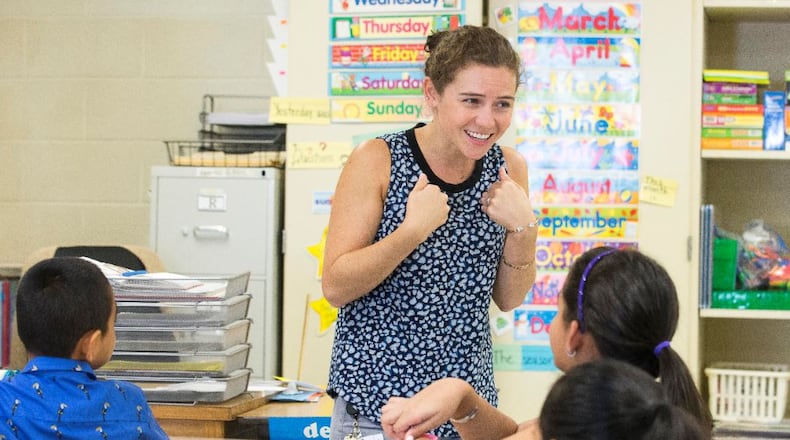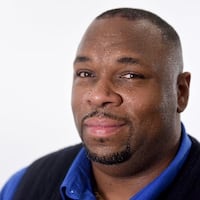“OK, class, what day is today?”
Friday.
“How do you spell Friday?”
F-R-I-D-A-Y.
Not a typical start for a high school class.
But it was how Claire Ragsdale began class recently for her 20 teenagers at the International Student Center, crossing through white light projected from a Promethian White Board to greet them all in a portable classroom several hundred yards from the school’s main building.
The few-of-its-kind school’s curriculum is similar to others in the district, but its students are not: Many speak just enough English to order a meal at a restaurant, but cannot get through typical lessons in math, science and social studies because of language barriers and other educational roadblocks. Royce Toombs, the school’s principal, said the school exists to provide the district’s many international and refugee students a transition center of sorts to allow them to ease into learning with teachers and coaches who help them along.
“We’ll teach them where they are (academically) with the expectation of where they should be,” said Toombs, who has worked with English Speakers of Other Languages students since 2000 when he was at Clarkston High School.
The DeKalb County School District school, in Decatur near Covington Highway, gets several hundred students a year who need more help before moving on to the district's traditional schools. Just over 400 students, from third grade through ninth or 10th, are currently enrolled. Toombs said about 1,000 students attended the school at some point during the 2016-2017 school year. The district has said its students speak more than 180 primary languages.
Metro Atlanta has fast become one of the most diverse regions in the country, with more than 20 percent of residents from Hispanic/Latino and Asian backgrounds. DeKalb County itself is a refugee resettlement district, with large pockets of families from other countries living and working along the Buford Highway corridor, where more than 1,000 immigrant-owned businesses line the street, and in smaller cities such as Doraville and Clarkston.
Students coming to the district are given an instructional assessment, the WIDA Screener, which measures students’ performance levels. If they score more than a 2.0, they are immediately sent to their neighborhood schools and placed in programs that provide some support to get students up to speed. A student scoring below 2.0 goes to the International Student Center.
The school operates two programs, including an intensive English program focused on language development through content, which sees students rolled into their neighborhood schools in as little as nine weeks. “The lab side,” as the other, more intensive program is known, will keep students for about two years. Students are assessed regularly to gauge their learning retention and other mastery benchmarks.
“The hope is, if I’m at zero now, I should not be at zero next month, Toombs said.
On the first day of school this year, Gabriella Guiol spent about 15 minutes with six children in her classroom going through introductions and getting them to take out pencils and paper. She supplied what they did not have.
Then, some students were hesitant to talk. That reluctance is often because of being in a new classroom. With international students, it could be for myriad reasons, said Tamara Banks, an instructional support specialist at the school who previously taught intensive English.
“A lot of them have never been to school,” she said. “So we work with a larger tool kit. You have to understand where kids are culturally. It could be disrespectful to talk directly to a teacher, an authority figure.”
Local cultural agencies like the Latin American Association or the Center for Pan Asian Community Services, which advocate for better understanding diverse backgrounds, regularly come to the school and hold awareness training for the teachers. The teachers employ different strategies for reaching their English Speakers of Other Languages, which could include finding common ground, using visuals. In some cases, it is more about teaching the students how to go to school, using rituals and routines to emphasize lessons. Banks likened their strategies to celebrity Chef Emeril Lagasse and his catch phrase: “Kick it up a notch.”
In Amber Riffle’s classroom, students were in three groups going through math problems using clue words, which assist in figuring out context. They were to read, look for clue words and solve the problems. One group was easily racing through the assignment but was admonished for communicating in Spanish. In the back of the room, paraprofessional Shahriare Khatun sat alone with one student, going through math problems other students were working on in groups.
“What is this?” she said to the student.
“Two?” the girl responded.
“And?” Khatun said.
“Minus two?” the girl asked.
“Let’s do it with the blocks,” Khatun said, nodding her head as the girl began subtracting blocks to lay out the math problem.
Muno Bubakar’s language class was going through dolch words — words such as “a, and, away, big, blue, can, car, find, for” — which help with reading fluency. Her students were in three different groups working toward the same goal. One group at desks worked aloud with the teacher while another did work on worksheets. In the back, a third group wore headphones and answered audio questions. She said they were grouped based on how much instruction they needed.
‘I’ve seen many students come a long way,” she said, walking between the groups and checking their work.
Ragsdale, the high school teacher, said she uses incentives to increase interaction, which is key to the students retaining information. That day, students were answering questions on a video they watched in class. Each correct answer received a sticker.
“I grade participation, so this shows me how they’re doing,” she said.
The stickers are collected on a sheet until it’s full. The students then go shopping in a closet filled with school supplies and candy.
As much as the school does to prepare students, Toombs said it needs to do more to help people understand how it works, and why.
There’s ongoing frustration from neighborhood schools that don’t understand the transitional school’s role. All students coming from the International Student Center won’t arrive at their neighborhood schools reading at grade-level, or proficient at the math they should be learning. But they will be proficient in English and ready to receive the additional support schools should be giving them, Toombs said. He got a complaint last year from a school about a student who started the year at the International Student Center, with someone lamenting that the student could not read.
“Give them time,” he said of the transitioning students. “There’s always going to be frustration, especially when (neighborhood schools) believe we’ve done what they’re supposed to do. We’re trying to really work on making sure people know what we’re doing and why we’re doing it.
“If a child could work on grade-level work, they wouldn’t be here with us.”
About the Author
Keep Reading
The Latest
Featured

